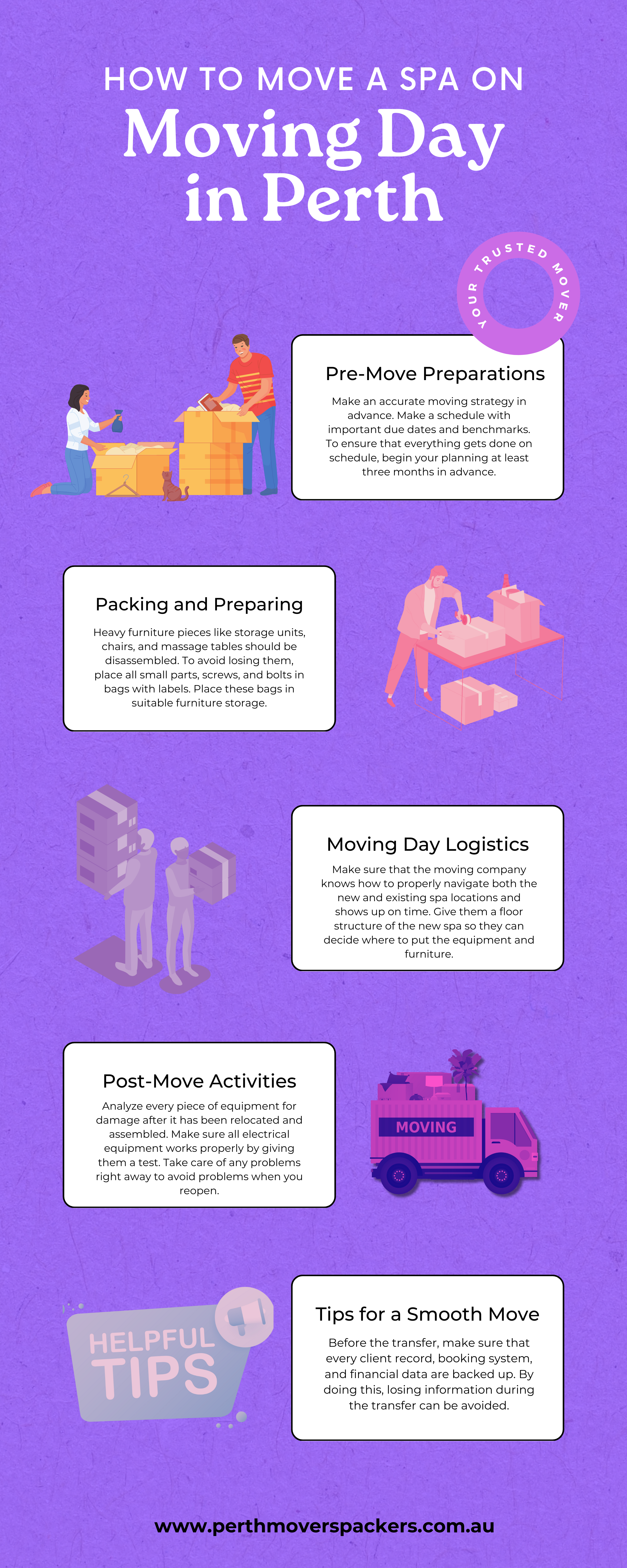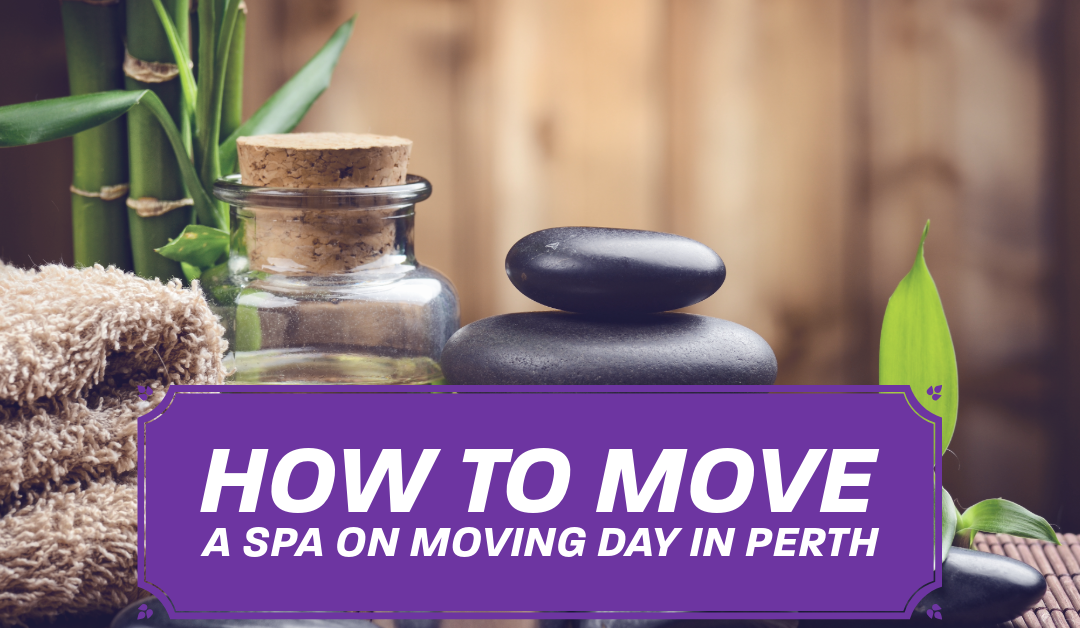Moving a spa requires careful planning and execution, regardless of the type of spa—day spa, beauty salon, or wellness center. There are several steps in the process, from guaranteeing the security of sensitive equipment to preserving business continuity. With the help of this all-inclusive guide, you’ll be able to relocate your spa without many problems to your business’s operations on a moving day.
Pre-Move Preparations
1. Planning and Timeline
Make an accurate moving strategy in advance. Make a schedule with important due dates and benchmarks. To ensure that everything gets done on schedule, begin your planning at least three months in advance.
2. Inventory and Equipment Assessment
Make an accurate list of all the supplies, furniture, and equipment in the spa. Select the goods according to how important and fragile they are. Examine each piece of equipment to see if anything needs to be replaced or repaired before the relocation.
3. Budgeting
Make sure your moving budget is complete. Add the price of hiring movers, packing supplies, any unexpected charges, and any planned changes at the new location. Create an emergency fund to pay for unexpected costs.
4. Hiring Professional Movers
Hire a moving company that is expert in handling relocations for spas. Look out for movers with experience moving affordable and fragile equipment. Get multiple estimates to compare costs and services, check their qualifications, and read reviews.
5. Notify Stakeholders
Give enough time for the move to all relevant parties. This covers workers, customers, vendors, and service providers. Tell them the new address and when you expect the relocation to be completed.
Packing and Preparing Equipment
1. Gathering Packing Supplies
Make sure you have everything you’ll need for packing, such as:
- strong moving boxes
- Packing paper with bubble wrap
- Blankets for furniture
- Labels and packing tape
- covers for specialized equipment (such as massage tables and face devices).
2. Disassembling Furniture
Heavy furniture pieces like storage units, chairs, and massage tables should be disassembled. To avoid losing them, place all small parts, screws, and bolts in bags with labels. Place these bags in suitable furniture storage.
3. Packing Fragile Equipment
For the protection of fragile appliances such as glassware, laser devices, and face machines, use packing paper and bubble wrap. To prevent moving during shipping, place these products in sturdy boxes and stuff any empty places with ripped paper or packing bags.
4. Labeling Boxes
All of the boxes have clear labels indicating what’s inside and where the new spa fits in. When labeling boxes that hold delicate objects, use the word “FRAGILE.” This will make it easier for the movers to handle the boxes carefully and make sure they end up in the right places.
5. Preparing Electrical Equipment
Remove every electrical device, then pack it safely. Repair any loose cables and pieces. Consider employing a qualified technician to help with the removal and reassembly of large or advanced equipment.
Moving Day Logistics
1. Coordinating with Movers
Make sure that the moving company knows how to properly navigate both the new and existing spa locations and shows up on time. Give them a floor structure of the new spa so they can decide where to put the equipment and furniture.
2. Managing Inventory
On the day of the move, assign a team member to supervise the inventory. Both when items are being loaded into the moving truck and when they are being unloaded at the new location, they should cross them off the list. This makes it more likely that nothing will be broken or lost during the transfer.
3. Safety Measures
Make safety your top priority when moving. To avoid injuries, make sure that all paths are free of obstructions and that heavy objects are carried and handled with the right methods. Assure movers take regular breaks and give them access to water and services.
4. Transporting Special Items
Think about shipping fragile or extremely pricey items separately. Things like expensive skincare items, private documents, or employees’ stuff might be best handled by you or by a professional shipping company.
5. Unpacking and Setting Up
Start with arranging the furniture and other equipment as soon as the items arrive at the new place. This includes waiting areas, treatment rooms, and rest places. To guarantee that the spa can start up as soon as possible, assemble heavy furniture and equipment.
Post-Move Activities
1. Inspecting Equipment
Analyze every piece of equipment for damage after it has been relocated and assembled. Make sure all electrical equipment works properly by giving them a test. Take care of any problems right away to avoid problems when you reopen.
2. Updating Business Information
Make sure that your business address is up to date across every platform, such as your website, social media accounts, business cards, and promotional materials. Remind your customers of the new address and the date of the reopening.
3. Staff Orientation
Schedule a staff introduction meeting at the new address. Introduce them to the new configuration, the emergency exits, and any newly installed facilities or equipment. By doing this, you can make sure they’re at ease and ready to support customers at their new location.
4. Client Communication
During the relocation process, make sure you communicate with your clients regularly and clearly. Send out notifications of the relocation, along with information about the new address, parking instructions, and any updates to the services or costs.
5. Hosting a Reopening Event
To attract customers to the new location, think about holding a reopening celebration or providing exclusive discounts. This can ensure a smooth transition for your organization and promote awareness.
Tips for a Smooth Spa Move
1. Backup Important Data
Before the transfer, make sure that every client record, booking system, and financial data are backed up. By doing this, losing information during the transfer can be avoided.
2. Prioritize Client Experience
Plan the relocation for less busy times to try to initiate as little disturbance as possible for your clients. Any changes or temporary closures should be informed well in ahead.
3. Maintain Cleanliness
As you set up the new place, make sure it’s neat and clean. When you reopen, this makes the place attractive for consumers as well as staff members.
4. Plan for Contingencies
Make backup plans so you’re ready for unexpected challenges. Having additional suppliers, temporary workplaces, and extra packing supplies are all examples of this.
5. Seek Professional Help
When faced with challenging activities like removing equipment, installing IT systems, or managing relocation-related legal issues, don’t be afraid to hire an expert.
Conclusion
Transporting a spa requires great planning, structure, and collaboration. You may guarantee an easy and effective transfer to your new location by following the instructions provided in this guide. Keep lines of communication open with everyone involved, give safety and hygiene priority, and remain adjustable to deal with unexpected challenges. Your spa may have a smooth transition and thrive in its new location with careful planning and implementation.

Related Blogs
Best Movers in Perth – Expert House, Office & 2 Men and a Truck
Every move has its own set of demands, deadlines, new logistics, and the possibility of a mishap....
Looking for the Best Removalists in Perth? Trusted Furniture Movers for a Stress-Free Move
Shifting to a new home or office premises marks a thrilling chapter in life, but it is indeed...
From Small Moves to Fridge Removals: Why Movers in Perth and Man with a Van Are Your Perfect Solution
Relocating is not all about the full household relocation. Sometimes, it’s about some boxes, big...

The Perth Movers & Packers Team boasts 5+ years of experience writing informative content about moving and packing. Our team of moving experts understands the hassles of relocating to Perth. Get helpful tips and advice for your move here. We are the #1 Removalists in Perth.




